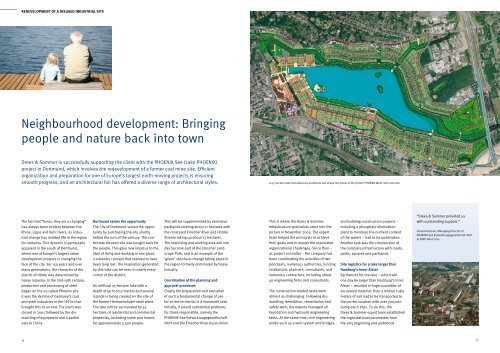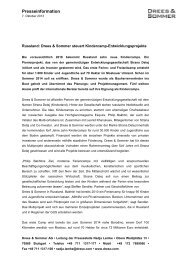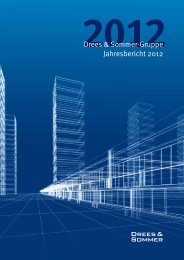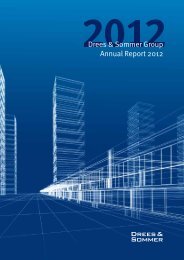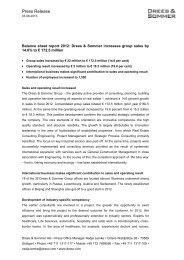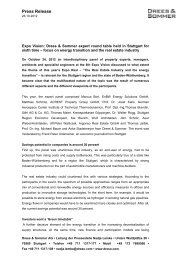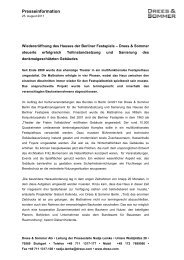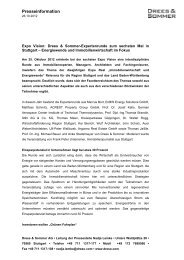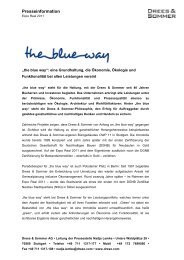32 - Drees & Sommer
32 - Drees & Sommer
32 - Drees & Sommer
You also want an ePaper? Increase the reach of your titles
YUMPU automatically turns print PDFs into web optimized ePapers that Google loves.
REDEVELOPMENT OF A DISUSED INDUSTRIAL SITE<br />
Neighbourhood development: Bringing<br />
people and nature back into town<br />
<strong>Drees</strong> & <strong>Sommer</strong> is successfully supporting the client with the PHOENIX See (Lake PHOENIX)<br />
project in Dortmund, which involves the redevelopment of a former coal mine site. Efficient<br />
organization and preparation for one of Europe’s largest earth-moving projects is ensuring<br />
smooth progress, and an architectural fair has offered a diverse range of architectural styles.<br />
The fact that “times, they are a-changing”<br />
has always been evident between the<br />
Rhine, Lippe and Ruhr rivers, as industrial<br />
change has molded life in the region<br />
for centuries. This dynamic is particularly<br />
apparent in the south of Dortmund,<br />
where one of Europe‘s largest urban<br />
development projects is changing the<br />
face of the city. For 150 years and over<br />
many generations, the character of the<br />
district of Hörde was determined by<br />
heavy industry: In the mid-19th century,<br />
production and processing of steel<br />
began on the so-called Phoenix site.<br />
It was the decline of Germany‘s coal<br />
and steel industries in the 1970s that<br />
brought this to an end. The plant was<br />
closed in 2001 followed by the dismantling<br />
of equipment and a partial<br />
sale to China.<br />
Dortmund seizes the opportunity<br />
The City of Dortmund seized the opportunity<br />
by purchasing the site shortly<br />
before the turn of the century: The 100hectare<br />
disused site was bought back for<br />
the people. This gave new impetus to the<br />
idea of living and working in one place,<br />
a visionary concept that seemed to have<br />
been long lost. The inspiration generated<br />
by this idea can be seen in nearly every<br />
corner of the district.<br />
An artificial 25-hectare lake with a<br />
depth of up to four meters and several<br />
islands is being created on the site of<br />
the former Hermannshütte steel plant.<br />
The lake will be surrounded by 42<br />
hectares of residential and commercial<br />
properties, including some 900 homes<br />
for approximately 2,500 people.<br />
This will be supplemented by extensive<br />
parklands totaling about 11 hectares with<br />
the renatured Emscher River and Hörder<br />
Stream taking up about 13 hectares.<br />
The new living and working area will one<br />
day become part of the Emscher Landscape<br />
Park, and is an example of the<br />
‘green’ structural change taking place in<br />
the region formerly dominated by heavy<br />
industry.<br />
Coordination of the planning and<br />
approval processes<br />
Clearly the preparation and execution<br />
of such a fundamental change of use<br />
for an entire district is a mammoth task.<br />
Initially, it posed substantial problems<br />
for those responsible, namely the<br />
PHOENIX See Entwicklungsgesellschaft<br />
mbH and the Emscher River Association.<br />
A 25-hectare lake and extensive parklands will shape the future of the former PHOENIX West coal mine site<br />
This is where the <strong>Drees</strong> & <strong>Sommer</strong><br />
infrastructure specialists came into the<br />
picture in November 2005. The expert<br />
team helped the principals to achieve<br />
their goals and to master the associated<br />
organizational challenges. Since then –<br />
as project controller – the company has<br />
been coordinating the activities of two<br />
principals, numerous authorities, funding<br />
institutions, planners, consultants, and<br />
numerous contractors, including about<br />
40 engineering firms and consultants.<br />
The construction-related tasks were<br />
almost as challenging. Following dismantling,<br />
demolition, remediation and<br />
safety work, the experts managed all<br />
foundation and hydraulic engineering<br />
tasks. At the same time, civil engineering<br />
works such as a weir system and bridges,<br />
and building construction projects –<br />
including a phosphate elimination<br />
plant to minimize the nutrient content<br />
of the waters – had to be undertaken.<br />
Another task was the construction of<br />
the complete infrastructure with roads,<br />
paths, squares and parklands.<br />
Site logistics for a lake larger than<br />
Hamburg’s Inner Alster<br />
Earthworks for the lake – which will<br />
one day be larger than Hamburg’s Inner<br />
Alster – resulted in huge quantities of<br />
excavated material: Over a million cubic<br />
meters of soil had to be transported to<br />
the correct location with over 300,000<br />
dump-truck trips. To do this, the<br />
<strong>Drees</strong> & <strong>Sommer</strong> expert team established<br />
the organizational parameters from<br />
the very beginning and undertook<br />
“<strong>Drees</strong> & <strong>Sommer</strong> provided us<br />
with outstanding support.”<br />
Ursula Klischan, Managing Director of<br />
PHOENIX See Entwicklungsgesellschaft mbH<br />
at EXPO Real 2010<br />
16 17


